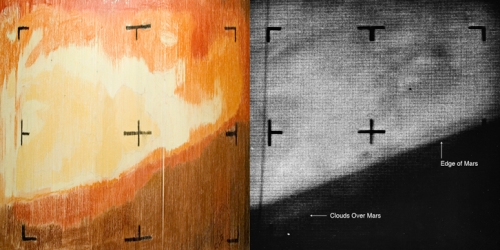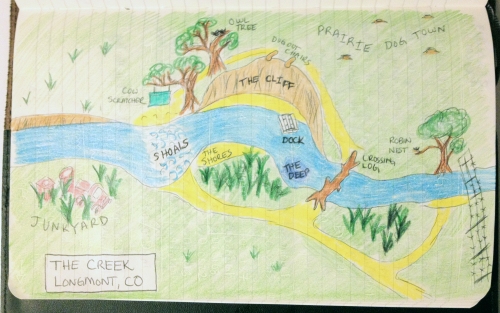by Shane L. Larson
I had the good fortune of knowing all my grandparents. My maternal grandfather, Robert Steele Kelher, Sr., was a chemist. I have vivid memories of spending time with him when I was young, but I don’t recall much of what we talked about. Now that I’m all grown up and a physicist, I often wish I could chat science with him. But one conversation I do remember vividly, was about Ford Thunderbirds. My grandfather once told me he had always dreamed of owning a Thunderbird. But in those later days of his life, when we would walk around the backyard together just chatting, he said he was glad he never got one; he was sure it would never have been as great as he imagined. He preferred the simple joy of savoring the idea of owning a Thunderbird.
I stumble across this memory now and then, and think about my own longings. This week, I am reminded that I often dream of Mars. I imagine an alternate reality where I get up in the morning and don a spacesuit instead of Levi’s, and walk the cold red deserts looking for clues to where we came from, clues to how Mars has changed over the aeons, and clues to what its future fate may be. But interspersed with those idle scientific longings and ponderings of an “other career” are daydreams about living and playing on Mars. What I wouldn’t give to spend a week, camping on Mars near the abandoned hulk of Spirit, once our faithful emissary on the Red Planet. Spirit was one of two Mars Exploration Rovers that landed on Mars in 2004, the ’57 Thunderbirds of their time. It spent a more than 2000 days roving across Mars, covering a total of 7.7 kilometers. Sprit has a twin, called Opportunity that is still roving, and this week we celebrated its 12th birthday on Mars.

I often dream of camping on Mars, maybe next to the Spirit rover.
I’m not yet as old as my grandfather was when we talked about Thunderbirds, but as I get older, I’m beginning to think that my future will forever be confined to the surface of the Earth. My wonderful daughter fears that she is preventing me from becoming an astronaut (an idea she is firmly against, especially after seeing “The Martian”). She has repeatedly seen us throw space probes and rovers at Mars, but she doesn’t have the perspective to know that while sending humans into space is possible, it is not easy.
Despite my fear that I was born a bit too early to be part of the generations that live and work in space, I feel fortunate that I have lived through the first age of Mars exploration. I’ve been witness to the years when our species obtained its first up close views of the red sands of Mars, and found the landscapes to be not as alien as we might have expected. Pick up any picture, any panorama from Mars and take a good look. Looking across the rubble strewn plains, across the shifting dunes of sand toward soaring mountains rising in the distance, you could easily believe you are looking at a picture of the American Southwest.

The “Rocknest Panorama” taken by the Curiosity rover in 2012. It does not look unlike places you might find on Earth. [Image: NASA, PIA16453]

The Hubble Space Telescope view of Mars, centered on the dark plain known as Syrtis Major [Image: Hubble Space Telescope]
The Martian atmosphere is thin (only about 1% as thick as Earth’s), but it is still strong enough to toss dust around the planet in globe-girdling dust storms that envelop the world for months on end. Our spacecraft have watched (and encountered!) swirling dust devils meandering across the plains, and rimes of frost condense out of the cold winter air. Once, long ago, we think the atmosphere was thicker, thick enough to move liquid water around the planet in a vast hydrological cycle like ours on Earth. What happened to Mars’ atmosphere? Why and how did it change, and what does that mean about our long term future? The Martian poles are studded by brilliant white ice caps that grow and shrink with the Martian seasons. As the poles grow and shrink, does the ice entomb a layered record of Mars’ storied past, like the Earth’s ice does?

We see familiar atmospheric and hydrological phenomena on Mars, similar but not identical, to what we see on Earth. L to R: Dust devils (seen by Mars Reconnaissance Orbiter), frost (at the Viking 2 site in Utopia Planitia), south polar ice cap (seen by Mars Global Surveyor).
One side of Mars is bulged out in a geologic area known as the Tharsis Bulge. It is a vast volcanic plateau dominated by four massive shield volcanoes, the largest of which is three times higher than Mount Everest as as wide as the state of Washington — it is the largest mountain in the solar system. We call it Olympus Mons. How did this massive volcanic landscape form? Why is it higher than the rest of Mars? Was it created in some astronomical cataclysmic event, or is there something about Mars’ geologic past that made it prone to massive mountain building?

Topographic map of Mars. Hellas (dark blue, right center) is lowest point on Mars; Olympus Mons (white peak, farthest left center) is highest point on Mars.
Since the 1960’s we’ve been sending spacecraft to Mars, and they’ve been dutifully sending back pictures and discoveries that lead to more questions. Mars, more than any other world, is the objet du désir. So as the Space Age unfolded, it was the target of many “firsts.”
Mars was the first planet to ever be visited by interplanetary spacecraft. On 15 July 1965, Mariner 4 flew past Mars, returning the first up close pictures of that distant shore. The very first picture was returned to Earth, but with some anomalous housekeeping data that suggested something might be wrong with the spacecraft’s tape recorder. While the issues were being sorted out and the computer was processing the data, the flight team had enough time to hand draw the first image directly from the data, pixel-by-pixel in true paint-by-number style. The first picture we saw was hand drawn (the computer later caught up and confirmed it could draw just as well as the Mariner 4 flight team). In all, Mariner 4 returned only 22 pictures, but those pictures showed us a barren, rocky world pock marked by craters, not (we thought) unlike the Moon.

The hand drawn image of the first Mariner 4 image (left) and the final computer generated image (right). [Images: NASA]

Mariner 9 showed us the first close up images of the caldera atop Olympus Mons (left) and the Valles Marineris (right). We have far better pictures of both today, but these were the first time humans had ever seen either. [Images: NASA]

Landscapes of Mars. Chryse Planitia seen by Viking 1 (L) and Utopia Planitia seen by Viking 2 (R). [Images: NASA]

The Curiosity rover was lowered onto Mars by a flying robotic sky crane. [Image: NASA]
All these “firsts” are fun and amazing to be sure. They inspire a kind of astonishment and awe that goes hand in hand with the uncontrollable urge to blurt out, “I can’t believe they just did that!” But in the end, the things that speak to me the most about Mars, the tantalizing bits that draw the mind and the soul into pondering the shifting red sands, are the pictures. The pictures inspire an unrequited longing to walk where none have walked before.

My grandfather, R. S. Kelher, Sr.
As I myself have grown older, I’ve learned to appreciate my grandfather’s thinking about his dream Thunderbird, especially in a society that seems increasingly commercialized. But when I think about Mars, when I imagine even just a few moments of being able to shuffle around in the light gravity, to turn over a stone scoured by a billion years of Martian weather, to let the red, red sands sift through my outstretched fingers, the longing for that experience is almost overwhelming. Given the chance, I think I’d trade the daydream for the opportunity. But Grandpa? You should know I remembered what you said, and I thought hard about it first.



![Ray Bradbury [Wikimedia Commons.]](https://writescience.files.wordpress.com/2013/12/ray_bradbury_1975_-cropped.jpg?w=195&h=240)
![Mars, as seen by the Hubble Space Telescope. (L) The Tharsis Bulge, showing the large shield volcanoes of Mars, and the Valles Marineris in the lower right. (R) The large, dark plain of Syrtis Major, as well as polar ice caps and fleeting clouds. [Images by NASA]](https://writescience.files.wordpress.com/2013/12/mars_hubble.jpg?w=500&h=239)





![Examples of extremophile life. (L) The Sully Vent in the Pacific; extremophile bacteria glean energy from the extreme heat and acidic water [NOAA image]. (R) The Grand Prismatic Spring in Yellowstone; different colored algae are tolerant of different water temperatures, giving the spring its banded appearance [National Park Service image].](https://writescience.files.wordpress.com/2014/01/extremophiles2.jpg?w=500&h=154)
![Tubeworms around a hydrothermal vent survive because the bacteria break down the acids, providing a way for the worms to chemically synthesize energy [NOAA image].](https://writescience.files.wordpress.com/2014/01/ex1104_img_20110806t202652z_rovhd_tub_live.jpg?w=270&h=151)




![[L] "Our Universe" by Roy Gallant (still one of my favorite books!) [R] Galileo observing the Moon, from Gallant's book.](https://writescience.files.wordpress.com/2013/07/ouruniverse_galileo.jpg?w=500&h=279)



![Four pieces of rock from the far side of the sky, which you can touch at the Adler Planetarium. [Upper L] A piece of Vesta. [Upper R] A piece of Ceres. [Lower L] A piece of the Moon. [Lower R] A piece of Mars.](https://writescience.files.wordpress.com/2013/07/4pieces.jpg?w=500&h=500)






